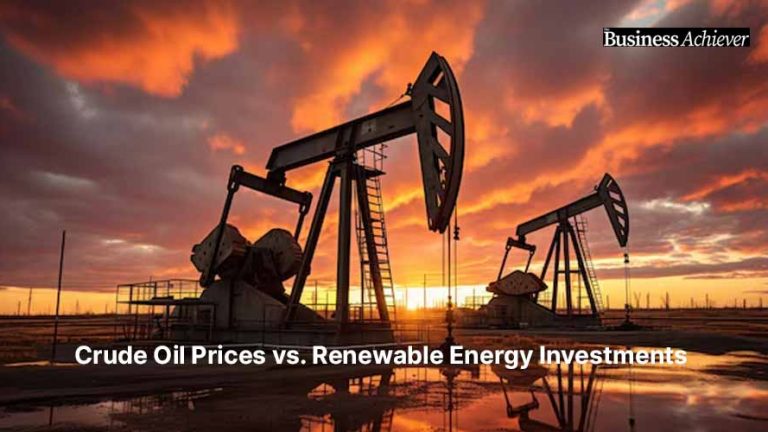Stay informed on market trends, policy shifts, and global energy strategies
The global energy landscape is undergoing a significant transformation, marked by fluctuating crude oil prices and a robust surge in renewable energy investments. This dynamic interplay between traditional fossil fuels and emerging clean energy sources is reshaping markets, influencing policy decisions, and redefining economic strategies worldwide.
Current Trends in Crude Oil Prices
As of February 24, 2025, crude oil prices have experienced notable fluctuations. Brent crude futures were trading at $74.29 per barrel, while U.S. West Texas Intermediate (WTI) crude futures stood at $70.18 per barrel. These figures represent a continuation of the downward trend observed in recent weeks. Several factors contribute to this decline:
1. Resumption of Exports from Kurdistan: Iraq has announced plans to resume exporting 185,000 barrels per day from Kurdistan’s oilfields through the Iraq-Turkey pipeline. This development is expected to enhance global oil supply, exerting downward pressure on prices.
2. Geopolitical Developments: Ongoing discussions aimed at resolving the Russia-Ukraine conflict have introduced uncertainty into the market. The potential lifting of sanctions on Russian oil exports could further increase global supply, influencing price dynamics.
3. Market Sentiment and Economic Indicators: Investor sentiment has been swayed by economic data and policy decisions. For instance, Sasol, a South African petrochemical company, reported a 31% decline in half-year profits, attributing it to falling oil prices and reduced sales volumes. Such corporate earnings reports can impact market perceptions and trading behaviors.
Renewable Energy Investments on the Rise
Despite the volatility in oil markets, investments in renewable energy have maintained a strong upward trajectory. Several key developments underscore this trend:
1. Policy Shifts Favoring Renewables: In Japan, Japan Petroleum Exploration (Japex) has announced a strategic pivot to prioritize oil and gas investments through 2030, citing challenges in securing fair returns from renewable sources due to rising costs. This highlights the complex decision-making processes energy companies face in balancing traditional and renewable energy investments.
2. Technological Advancements and Cost Reductions: The cost of renewable energy technologies has seen a dramatic decline. Over the past few decades, the price of solar panels has plummeted by 99%, making solar energy more accessible and competitive. Similar trends are observed in wind energy and battery storage technologies, contributing to the increased adoption of renewables.
3. Global Energy Demand and Electrification: The International Energy Agency (IEA) projects that global electricity demand will double by 2050, driven largely by the electrification of various sectors and the proliferation of data centers. This surge in demand presents a substantial opportunity for renewable energy sources to play a pivotal role in meeting the world’s energy needs.
Interplay Between Crude Oil Prices and Renewable Energy Investments
The relationship between crude oil prices and renewable energy investments is multifaceted:
- Investment Decisions: Historically, high oil prices have made renewable energy projects more attractive by comparison, as they offer a hedge against fuel price volatility. Conversely, lower oil prices can pose challenges for renewables by making fossil fuel energy more economically appealing in the short term.
- Policy and Market Dynamics: Government policies, such as subsidies for renewables or carbon pricing mechanisms, significantly influence the energy mix. For instance, recent policy shifts in the U.S. under President Donald Trump’s administration have emphasized fossil fuel production, potentially impacting the trajectory of renewable energy investments.
- Corporate Strategies: Energy companies are adjusting their portfolios in response to market signals. BP, for example, has faced challenges with its aggressive shift toward green energy, leading to financial underperformance compared to rivals who maintained a focus on fossil fuels. This underscores the complexities and risks associated with transitioning to renewable energy.
Regional Perspectives: India’s Energy Landscape
In India, the energy sector is navigating the balance between traditional and renewable sources:
- Crude Oil Imports: India’s crude oil basket, a weighted average of Dubai and Oman (sour) and Brent Crude (sweet) prices, serves as a benchmark for the country’s import costs. Fluctuations in global oil prices directly impact India’s energy import bill and economic stability.
- Renewable Energy Initiatives: India has set ambitious targets for renewable energy capacity, aiming to reduce dependence on imported fossil fuels and enhance energy security. Investments in solar and wind energy projects have been prioritized, supported by favorable policies and international collaborations.
Future Outlook
The energy sector is poised for continued evolution:
- Market Projections: Goldman Sachs forecasts that Brent crude oil prices will average $76 per barrel in 2025, influenced by ample supply and OPEC+ production strategies. Such projections are essential for stakeholders in planning and investment decisions.
- Sustainable Transition: While fossil fuels currently dominate the energy mix, the momentum toward renewable energy is undeniable. Technological innovations, coupled with policy support, are expected to drive further investments in clean energy, contributing to global efforts to combat climate change.
In conclusion, the dynamic interplay between crude oil prices and renewable energy investments reflects the broader transition occurring in the global energy landscape. Stakeholders, including governments, corporations, and consumers, must navigate this complex environment, making informed decisions to balance economic interests with environmental sustainability.






Add comment